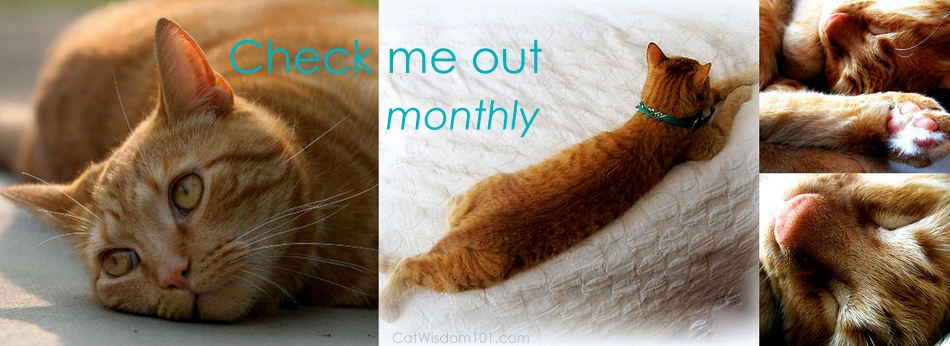Your Cat’s Monthly At Home Physical Exam- Part 1

We’ve shared our vet’s at home 5-minute home exam video but I though it would be useful to have written step-by-step details and tips. We’re happy to announce a monthly series about at home exams from Georgia Barbush, a Registered Vet Tech in California.
Your Cat’s Monthly At Home Physical Exam- Part 1
Have you ever found a strange lump or bump on your cat’s body and wondered, “How long has that been there?” Or been surprised at the vet‘s office to find out your cat has gained or lost weight? Keeping up with annual vet exams is a vital part of maintaining our pets’ health, but many pet owners underestimate their own abilities to detect changes in our pets’ health in between trips to the vet. Subtle or gradual changes can easily go unnoticed unless we take an active role in monitoring our pets’ well-being.
Giving your cat monthly physical exams at home allows you to provide your veterinarian with more detailed information and significantly improves your chances of catching disease in its earliest stages. This series of articles will cover the basics of evaluating your cat from nose to tail. To get the most out of these monthly exams, keep a record of your findings so you can compare month by month and look for trends. If any results from an exam are out of the normal range, give your veterinarian a call.
Part One – TPR TPR stands for temperature, pulse, and respiration.
These basic vital signs form the foundation of any general physical exam. While this set of signs is commonly referred to as TPR, I actually like to think of it as RPT because this is the order you’ll want to go in for the most accurate results.
Respiration. We want to start with respiration because it is the least stressful sign to evaluate. You will not even need to touch your cat to count breaths per minute; just watch her breathing while she is awake, but relaxed and count the number of times you see her inhale over 60 seconds. Cats will typically breathe 10-30 times in one minute. You’ll want to check respiration while your cat is relaxed because excitement or stress can increase respiratory rate significantly.
Pulse & Heart Rate. It is important to note the difference between pulse and heart rate. While heart rate refers to the actual contractions of the heart muscle, pulse refers to the palpable propulsion of blood through the arteries. In a healthy animal these two rhythms are in sync, but some conditions can lead to a pulse deficit, where the pulse lags behind the heart rate. To do a simple check of your cat’s heart rate, you can gently hold his chest wall between his front legs and feel for a heartbeat. If you’re using a stethoscope, you’ll want to place the diaphragm on the left side of the chest, just behind the elbow.
Either technique may take a little trial and error before you find just the right location. A normal heart rate in cats ranges from 150 to 240 beats per minutes. To check for pulse feel on the inside and towards the top of a hind limb. You will feel two large muscles here that meet lengthwise near the center. Put two fingers into the groove where the two muscles meet and press very gently. You should be able to feel the pulse in that large femoral artery. If you cannot feel it, try moving your fingers around the area slowly. Also, do not to press too hard; this can close the artery off so it stops moving blood and you will not be able to feel anything. In order to check for a pulse deficit, feel for the heart rate with one hand and pulse with the other. If your cat’s pulse is slower than his heart rate, contact your veterinarian right away.
Temperature. We want to check temperature after respiration and heart rate because it is the most stressful of the three and stress leads to elevated heart and respiration rates. If you have a very good helper or have a very tolerant cat, you can take the temperature rectally. Only use a digital thermometer (never mercury) and coat the end with a water-based lubricant. If taking a rectal temperature is too daunting, you can use an ear thermometer for pets. These vary in their accuracy and ease of use, so do some research before your purchase. A normal temperature for cats is between 100.5°and 102.5°. If your cat has been sunbathing or playing hard, it is normal for her temperature to be slightly elevated. In this case, wait an hour or two and check again to ensure an accurate reading. Now you know how to check your cat’s basic vital signs!
Stay tuned for Part Two: Overall appearance, temperament, hydration, and weight.
Taking proper care of our pets with good nutrition and vet care can be expensive. It’s one of the reasons we like offering our Cat Wisdom 101 readers so many giveaways.
Would you like to win our $100.00 shopping spree for any pet products from Entirely Pets? Today is the last day to enter. The odds of winning are excellent. To enter, simply leave a comment at our blog post before midnight EST tonight. The winner will be announced tomorrow, when have yet another $100.00 Visa Gift Card + Giveaway!





10 Comments
Kitties Blue
This is a great giveaway and we would like to be entered.
This was an excellent post. I wish I had done this with a couple of my cats (had I known to or known how). I might have saved or at least extended their lives. I cannot wait to find out more. Hope my cats cooperate when I try these things. They are suspicious the moment I try to pick them up. Janet
Angel Abby
We have to agree with Brian until you got the temperature taking we were all in!!!
Hazel Marie Snyder
OBoy, not feeling well and didn’t double check for errors. To finish, my human scale doesn’t show ounces, my cats aren’t little, so I go only by pounds and their appearance.
Also wanted to make sure my name’s in the drawing.
Brian
That was great…until the temperature thing. We are looking forward to morea,
Hazel Marie Snyder
It’s so great of you toshow
er allthe ggive a ways ti help us who struggle.
I’ve listened to your video about 5 times. I’m keeping this list. I love the facts I’ll have right on hand when I do
my check ups. I use a people
scale. I just go by pounds and apperance. My vet was actually impressed with my cat notebook!
scale, which wouldn’t show
Melissa
This is such an informative post…I always try to be extra vigilant at home with my fur babies to catch problems before they advance 🙂
Amanda Heck & Cat Rocco
My Cat Rocco would Love to Win $100 and I have a good idea of what he wants! Thanks!!
Sue Brandes
Thank you so much. I am always checking out my kitties but; this shows me more I should be doing.
Andrea
This is a great post with some real and practical advice. You might also want to know that if you have trouble feeling a pulse even after moving your finger, try a different finger. I usually use my middle finger.
I used to weigh my cats weekly and send the results to my veterinarian, that is until Mewdy Blue died. It is so hard to even think of making a list of my cats without his name on it………………..I guess I should get back into that routine though. I also try to do a lump check every week while petting/massaging each cat. I’ve been able to catch lumps early by this regimen.
Layla Morgan Wilde
Andrea, that’s good tip about trying another finger. What kind of scale are you using?